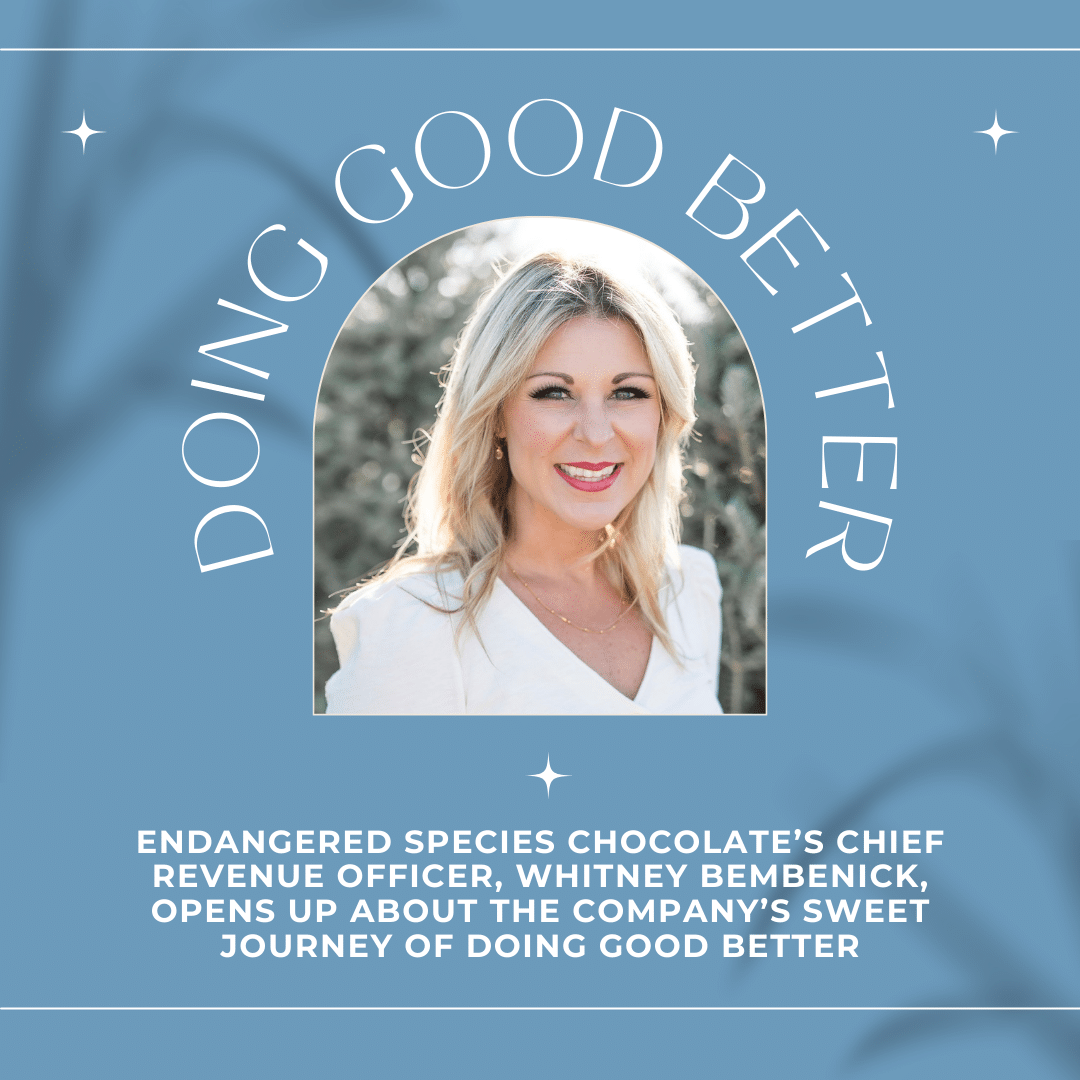Located in Indianapolis, IN, Endangered Species Chocolate (ESC), has been creating premium chocolate since its inception in 1993. In the visionary pursuit of “doing good better” the team at ESC has embraced a mission for delivering joy through exceptional chocolate and championing conservation organizations. This unique combination is brought to life through the company’s 10% giving program, as well as a commitment to sourcing and creating premium products that deliver on consumers wants and needs from confectionery goods.
“After years of growth in the natural food space, as well as the discovering the core of what drives excellence in leadership, ESC has evolved and formalized our vision into the aspirational pursuit of doing good better,” says Whitney Bembenick, Chief Revenue Officer at ESC. “Our mission to ‘seed joy through abundant giving’ is enabled through our values to serve, give and cultivate others. Living, breathing, hiring, firing and making major decisions through the lens of mission, vision and values has been transformative for the future health of our organization.”
Placing mission, vision and values at the center of the organization is what the company believes will unlock it’s next 30 years of success.
“About two years ago we realized that our vision was really a business objective or ‘big hairy audacious goal (BHAG)’ – and while envisioning a day when we would give forward $1M annually was aspirational for growth, it was not visionary enough,” Bembenick says. “It did not embody the reality of ESC, which is to conduct business in a restorative manner that not only does good immediately but also creates a ripple effect towards a thriving future.”
Indeed, from the beginning ESC has sourced sustainable cocoa. Of course, in the 30 years since ESC was founded, sustainable certifications have evolved and become more prevalent in the industry. Today, Endangered Species Chocolate currently participates in two sustainability programs: FairTrade America and Cocoa Horizons. Bembenick suggests that both of these systems empower cocoa farmers to enhance their quality of life while also fostering a sustainable future.
“The lens of sustainability is a gate keeper to doing business in all of our cocoa sourcing, processing and procedures,” Bembenick says.
Over time, ESC has adapted to modern innovations and recognized the vital role innovation plays in the industry, although it took the company some time to fully embrace this approach.
“After decades of success, we had fallen into a routine and were lagging behind the innovations and disruptions in our industry,” Bembenick says. “Thankfully, we began to realize we needed to pivot, setting in motion a domino effect of fantastic energy focused on our road map for growth and namely, innovation.”
Through a system called “jobs to be done,” the ESC team identified the key needs not being met today and developed product solutions that would close those gaps.
“At the onset of our pivot in 2022, we turned our traditional innovation funnel on its side and re-defined the filters of that funnel. We are no longer looking through a vertical tunnel of what influences the consumer, but instead tilting our head sideways to look through a cylinder that considers the market, the consumer and our mission, vision and values all at one time. 2024 will be a year of Endangered Species creating change for the category through innovative new products and business practices that do good better,” Bembenick says.
Looking Ahead
Bembenick believes that healthy organizations change and grow, therefore the company’s needs change. You, as an individual, take in and learn different things every day, therefore you change and grow.
“Syncing your growth to the needs of your team is the fuel that keeps refining and developing great leaders and great organizations,” Bembenick says.
After three decades of success in the confectionery industry, ESC is now bringing its unique energy to the natural foods space. While the average confectionery business generates 20 to 40% of its revenue from seasonal products, ESC, until 2024, generated less than 1% from seasonal collections.
“Starting in 2024, we are bringing the shopper re-sealable bags of seasonally shaped chocolate for every major season – for example, koala bears for Valentine’s Day and bats for Halloween,” Bembenick says. The company has also experienced significant growth in the baking sector and boasts the fastest-growing market share in natural chocolate baking chips. Through partnerships with major retailers like Walmart, ESC is set to more than double its presence in the baking aisle in 2024.
Inside the chocolate category, Bembenick says that ESC is bringing three flavors of perfectly sized mini truffle bars, wrapped individually in packages of five. At just 150 calories a piece and made with coconut oil instead of palm oil, these delicious treats serve ESC’s customers in one of their biggest areas of need: indulgence without the guilt.
ESC also recognizes that chocolate shoppers craves unique and creative experiences that taste delicious, so combining the company’s high-quality chocolate with a clever experience has proven to be an ideal avenue to explore.
“To cap off a year filled with innovations, we’re excited to introduce what we coin as the category disruptor: ‘Dip ‘n Joy.’ This product taps into a deeply rooted behavior of consumers breaking off chocolate from their bar of choice and dunking it directly into their jar of peanut butter at home,” Bembenick says. “Marrying that behavior with modern lifestyles and nostalgic forms we created a single-serve product of chocolate batons nestled next to a valley of peanut butter, caramel or almond butter for the perfect convenient snack. As you can tell, 2024 is the year we are going to deliver on our road map to growth through the pillar of innovation.”















